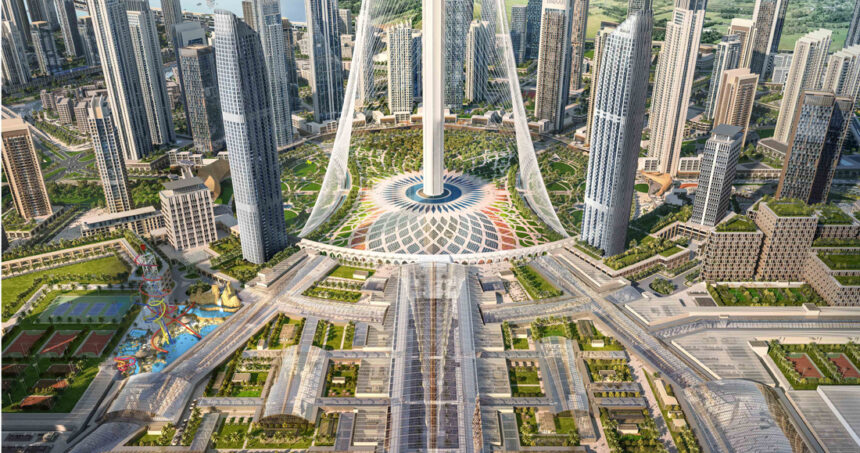UAE: A data centre and campus dedicate to artificial intelligence (AI) developing in the United Arab Emirates (UAE). Marking one of the largest computing infrastructure projects globally. The project, known as Stargate UAE, it will redefine the scale and capabilities of AI data centres worldwide.
The Abu Dhabi-based AI company G42 has partnered with prominent technology firms including OpenAI, Oracle, Nvidia, and SoftBank Group to establish Stargate UAE. This facility is recognize as the largest AI data centre. Integrated into a network of OpenAI-linked data centres around the world. The project is a endorsement of the UAE’s capacity to host large-scale technological infrastructure to economic, societal, and business demands.
OpenAI’s chief executive, Sam Altman, expressed support for the initiative via social media platform X, emphasizing the cooperative efforts of governments and praising Sheikh Tahnoon’s commitment to artificial general intelligence (AGI) and his personal support for OpenAI.
Understanding Data Centre Capacity
Data centre capacity, typically measured in kilowatts (kW) or megawatts (MW), refers to the physical space and power required for data storage and processing. Data centres are generally into small (up to 1,000 sq ft), medium (10,000 to 50,000 sq ft), and large (over 50,000 sq ft) sizes.
Read More: G42 Forms Strategic Partnership with OpenAI, Oracle, and Nvidia to Launch Stargate UAE AI Hub
Alongside power consumption, capacity accounts for cooling systems, facility size, server types, and crucially, the number of graphics processing units (GPUs) housed. Recently, sustainable and eco-friendly technologies have increasingly adopted to enhance efficiency and reduce environmental impact.
Power Capacity: What 1MW and 1GW Represent
The capability of data centres is describe by their power usage. One megawatt (1MW) of power can support approximately 1,000 Nvidia Blackwell GPUs for training AI models or handle tens of millions of ChatGPT-style queries daily in inference mode.+
According to Mohammed Soliman, director of the strategic technologies and cybersecurity program at the Middle East Institute, 1MW can sustain a mid-sized national language model serving an entire country.
At the gigawatt (1GW) level, continuous power is sufficient to operate around one million top-tier Nvidia GPUs Factoring in cooling and power conversion overheads. This level of consumption is comparable to the annual electricity usage of a city the size of San Francisco or Washington, D.C.
Data Centre Construction Costs and Considerations
The cost of building data centres varies widely, ranging from millions to billions of dollars, influenced by size and location. Expenses include land acquisition, construction, server equipment, cooling infrastructure, power supply, security (both physical and cyber), and staffing.
Operating cost increases over time and site selection remain critical factors. The most expensive markets for data centre construction is identify as Tokyo, Singapore, and Zurich.
The China Telecom Data Centre, previously the world’s largest before Stargate UAE, has a capacity of 150MW and was constructed at an estimated cost of $3 billion. Stargate UAE’s initial 1GW phase, built in partnership with Cisco and SoftBank. It is project to cost approximately $20 billion and forms part of a planned 5GW campus.
Stargate UAE’s Dominance Among Global Data Centres
Stargate UAE’s scale surpasses all current major data centres, including Google’s and Microsoft’s facilities, which have capacities of 100MW and 50MW respectively. With construction costs reported at $5.5 billion and $3 billion. Apple’s Arizona data centre similarly has a capacity of 50MW, costing around $2 billion.
Upon completion of the entire 5GW campus, Stargate UAE will be capable of hosting about 2.5 million GPUs. Consuming power equivalent to that of several medium-sized US cities combined.
Also Read: Abu Dhabi’s G42 and Cisco Ink Initial AI Investment Agreement Ahead of US President’s Visit
UAE’s Growing Data Centre Market
The UAE is currently home to at least 17 data centres, with plans for significant expansion. Abu Dhabi’s Khazna Data Centres, one of the largest operators in the Middle East, operates a capacity exceeding 360MW. He has also announced plans for a new 100MW campus in Ajman.
Khazna’s CEO Hassan Al Naqbi, have projected the UAE’s total data centre capacity to increase to 850MW by 2029.
A hyperscaler data centre valued at approximately Dh2 billion, planned in Dubai by telecom provider du and Microsoft. Additionally, Awqaf Abu Dhabi has expressed openness to investing in data centres to diversify assets and enhance economic resilience.
Global technology giants such as Microsoft, Oracle, Google, and Alibaba have also made investments in the UAE’s data centre sector.
Strategic Location and Renewable Energy Prospects
The UAE’s strategic position at the crossroads of South Asia, East Africa, and the Middle East places it within the latency targets preferred by hyperscalers. This geographic advantage is expected to attract continuous demand for data centre services.
Moreover, Stargate UAE is anticipated to stimulate the development of new clean energy projects by providing stable demand. Making renewable energy investments more financially viable, according to experts like Mohammed Soliman.
Conclusion
The Stargate UAE initiative is set to become a landmark in global AI infrastructure. Dwarfing existing data centres in size, capacity, and investment. With extensive collaborations, strategic location benefits, and a focus on sustainable energy integration. The UAE is positioned to become a leading hub for advanced computing and AI technologies in the coming decade.
Follow 10X Times for more business news.






